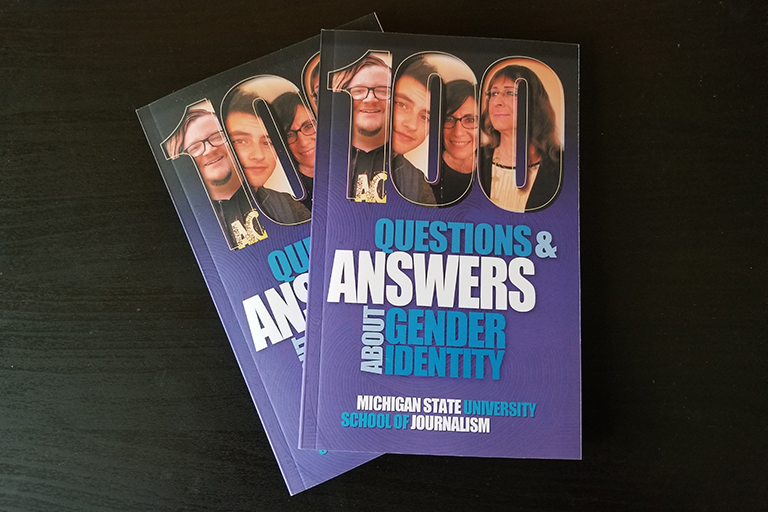When Journalism’s Editor in Residence Joe Grimm came across an article in the State News about transgender individuals in the East Lansing community, he was moved by the personal testimonies. Grimm knew he had to recruit one of the featured individuals, Kalib Watson, for the next edition of the Bias Busters series: 100 Questions & Answers About Gender Identity.
“[Grimm] said, ‘Hey, I’m doing this book. We could really use your help on it for your background knowledge,’” said Watson, then a Professional Writing junior. “And that was how I ended up getting enrolled in the class.”
Spearheaded by Grimm, JRN 492 is a journalism seminar course in which students are able to tackle some of society’s toughest questions about cultural groups through the publication of a book, from initial research to final edits. The guide about gender identity is the twelfth book in the series, meaning Grimm and his students have now answered 1,000 questions.
Gender Identity
Given the continuing change in laws and language surrounding the LGBTQ+ spectrum, this is a very timely guide. The students tackled questions like: What is gender dysphoria? How do people decide when they should come out? How does one respectfully refer to a transgender person? The 74-page book is a starting point for people who have introductory questions about gender identity.
“This guide explains the differences between gender and sexuality, answers many of the questions that trans people say others are asking them and coaches people on how to have safe, constructive conversations,” said Grimm.
At the beginning of the semester, the class went to MSU’s LGBTQ Resource Center and asked Director Deanna Hurlbert for direction, since the topics of gender identity and sexuality are so broad. When she mentioned that the center was getting a lot of questions about identity specifically, Grimm decided that they should launch a guide on that topic first.
After extensive research through data collection and personal interviews, the students condensed the information into 100 reader-friendly questions and answers.
“[Readers] don’t have to Google questions and get a generic answer,” said Watson. “These are real answers coming from real people that are specific to different scenarios and that helps people understand not only the question they’re trying to answer, but also the context around it.”
A Tough Topic
The Bias Busters series has taken on a variety of topics over the years, from immigrants to veterans to African Americans. But due to a lack of understanding and the frequent dissemination of misinformation, gender identity was an especially challenging concept to tackle.
“Sometimes it’s hard to relate to someone you think might be a lot different than you. Gender identity is one of those things,” said alumna Caitlin Taylor ’17, who worked on this guide as a Journalism senior. “Sensationalized headlines about bathroom bills and the transgender military ban can be easily misunderstood by folks who have never met someone who is transgender.”
It was also difficult to collect information, as extensive data was hard to locate and primary sources were hesitant to get involved.
“It’s hard to find trans people,” said Watson. “You don’t want to be outed or ostracized or tell someone and have them ask, ‘What does that mean?’ It’s hard to talk about those issues with people in general and have them understand.”
Working with Grimm
When working on an important project like the Bias Busters series, it’s always helpful to have access to a considerate managing editor. According to Taylor, Grimm has a way of working with students as if they were his professional equals.
“Aside from working on a really important, politically-relevant topic, working with Grimm is always a joy,” said Taylor. “He guides and empowers you to reach out of your comfort zone and takes each of your ideas into consideration. Being able to soak up his wisdom over the production period was definitely one of my favorite parts about working on the book.”
Grimm’s undertaking of this series is a clear indication of his ethical standards. With each new guide, greater levels of acceptance, understanding and tolerance follow.
“I hope this guide kickstarts a chain reaction,” said Taylor. “I hope that the guide can become part of a larger movement toward the safety and acceptance of transgender and gender-nonconforming people because we all need to do better.”
Followers of the series can look forward to guides on sexuality, local policing, human trafficking and a double-guide on Gen X and Millennials in the future.
By Kaitlin Dudlets
